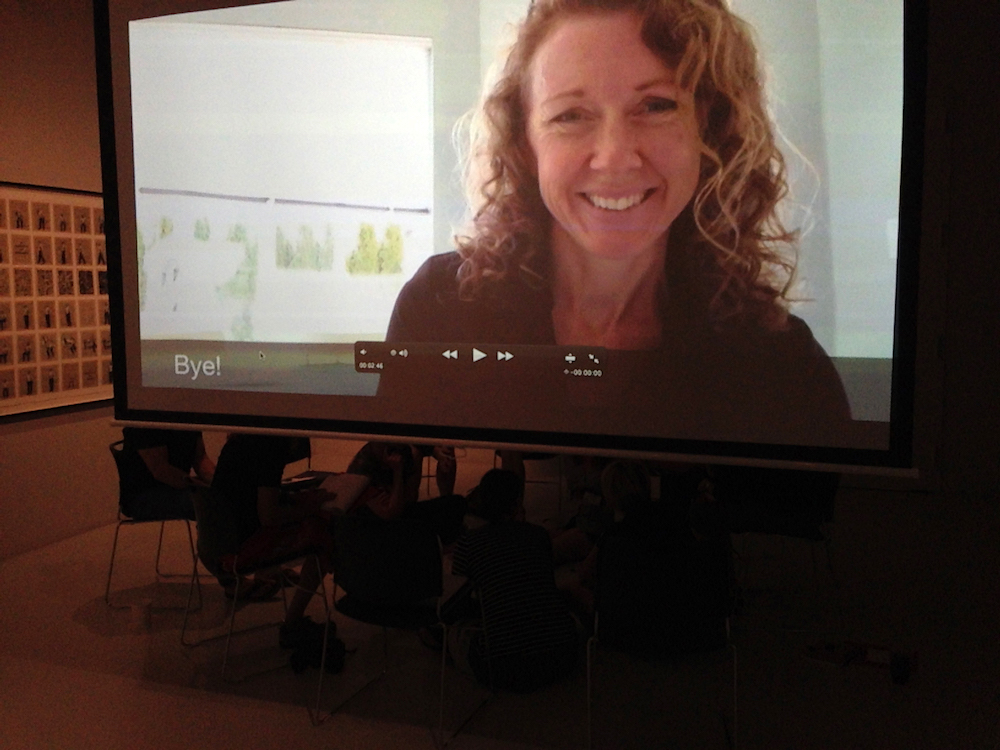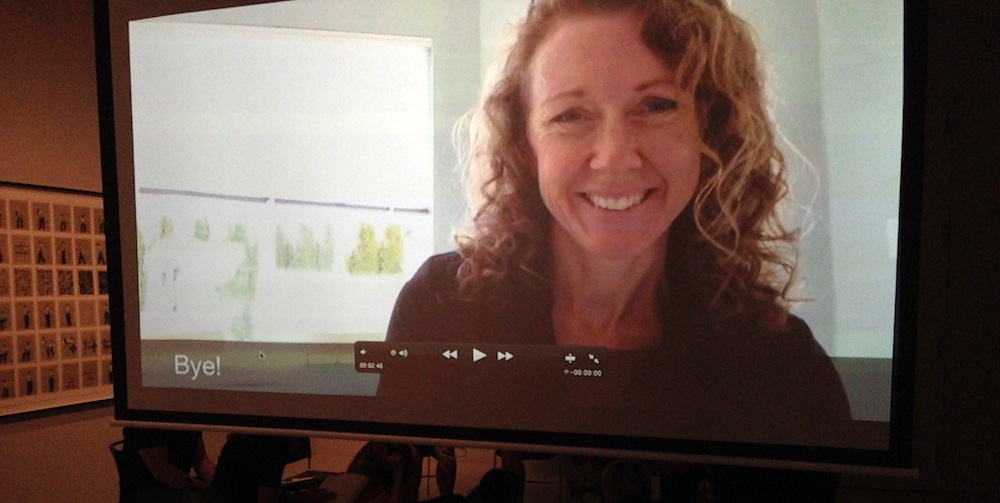
Art21 Educator Tricia Fitzpatrick, virtually participating at an Art21 Educators Summer Institute she wasn’t able to attend in person. Photo by Don Ball.
Art21 Magazine’s first Educator-in-Residence, Tricia Fitzpatrick, will share her insights on arts education in our May / June issue, “Rust,” through articles on lesson plans and reports from the classroom. Fitzpatrick teaches grades 9 through 12 at Cawthra Park Secondary School in Mississauga, Ontario. Unlike most teachers in the Art21 Educators program, Fitzpatrick teaches science, but her approach to education is holistic: she values creative thinking, experiential learning, and locating the places where art and science intersect.
In 2015, Fitzpatrick and New York Close Up artist Mary Mattingly collaborated on an event at Art21’s symposium on art and education, Creative Chemistries. Together, they developed a shared website with information on garbology, and led a group to ceremonially bury objects in Central Park.
Art21: Why were you initially drawn to the Art21 Educators program?
Tricia Fitzpatrick: I was introduced to Art21 Educators by my friend and colleague, Don Ball, with whom I have been collaborating for the better part of a decade. We both love the intersection of art and science and try to collaborate as often as we can. Since 2003, we have worked together on an international travel program at our school for visual-art and science students. We have traveled to various countries in Latin America (and most recently Nunavut), combining homestays and community service with an exploration of the art, culture, and ecology of the areas we visit.
I will never forget the day Don came to me, very excited about the Art21 Educators Summer Institute. I had known about the Art21 television series for some time, but neither of us knew of the educators program. The year we applied, visual-arts teachers were required to partner with a teaching colleague whose subject area was not visual art. At that point the program had never hosted any Canadians, nor would applications be accepted from science teachers. In fact, the program’s website explicitly said the program would accept teachers in the humanities and asked science and math teachers to wait until future years when the program might be equipped to expand into those subject areas. Don was very persistent, and we applied nonetheless. I am so glad we did.
So there we were, the first Canadians, and I was the first science-teacher participant. That Summer Institute was the beginning of the best ongoing professional development and networking experience of my career.
Tricia Fitzpatrick with her class on a 2016 trip to Arviat, Nunavut. Photo courtesy of Tricia Fitzpatrick.
Art21: How would you describe the Art21 Educators program?
TF: Art21 Educators is, more than anything, a community. The Summer Institutes, the Ning online platform, and regular online video conferencing have created a cohesive, strong network that I have never experienced elsewhere. It is a group of dynamic, like-minded people who want to make a change in this world by inspiring our students through contemporary art and equipping them with the twenty-first century skills of creativity, communication, critical thinking, and collaboration.
Art21: How has Art21 Educators changed your practice?
TF: Even before my involvement with Art21, I was no stranger to bringing contemporary art into the science classroom or bringing my science students to contemporary art exhibitions (there’s nothing like bringing biology students to an art gallery to see Wim Delvoye’s Cloaca!). Art21 Educators opened a door to resources and ideas that I could use to further the connections between artists and scientists and the work they do. Suddenly I had a library of resources—videos, Educators’ Guides—that I could use in my class, as well as a network of educators to help me brainstorm, problem-solve, and reflect on my teaching practice. The connections I have made with other educators through the Ning online community and other social networking have been incredible—a great way to get feedback on my work, gather new strategies, and find support and encouragement. It is a wonderful thing to have a group of colleagues who don’t think it’s crazy to use contemporary art to teach scientific concepts!
Art21 Educators Tricia Fitzpatrick and Don Ball on a field trip. Photo courtesy of Tricia Fitzpatrick.
Art21: How do you continue to stay involved with Art21?
TF: Since my first Summer Institute, I have remained connected to the community on Ning, sharing my work on the blog and following what other educators have been up to. As an alumna, I have presented sessions at some of the Summer Institutes, and I co-presented a workshop with Mary Mattingly at the Creative Chemistries forum in February 2015. I also worked with Don on the “Art Educators Lab” at that event, helping to showcase the work of the Art21 Educators. Don and I also presented our Art21 work and our other art-science collaborations at the Association of Interdisciplinary Studies conference in 2014 as well as at the Ontario Art Teacher’s annual conference in Toronto.
This year I have taken on the role of mentor to the 2016 cohort of Art21 Educators. We meet monthly in video conferences, supporting and encouraging each other, sharing experiences and ideas, and helping each other to effectively incorporate Art21 resources and strategies into our teaching. My group is marvelous and diverse: two teachers from Canada, two from the United States, and one from Mexico. What fabulous learning we have had with such different perspectives being brought to the table!
Art21: What are you most excited about for the current school year with Art21?
TF: I am very excited about the connections that I have made with my mentor/mentee group this year. The Summer Institute established an incredibly positive, supportive community that has continued through the school year. The new cohort is buzzing with energy and ideas—as are the alumni! We have begun a variety of different collaborations with each other and with our students. Social media and online video tools allow our classrooms to be easily connected, to share ideas, and to learn and create art together. I am looking forward to connecting my science classes with the art students of other educators in my mentor/mentee group this year.
Fitzpatrick’s science students participating in “Great Art for Great Lakes,” a fall 2016 project with a local artist exploring the theme of water and health of the Great Lakes. Photo courtesy of Tricia Fitzpatrick.
Art21: Describe a specific work of art, artist, or exhibition that has recently inspired you or your teaching practice.
TF: I am particularly interested in how scientists and artists work and think in similar ways, when investigating environmental issues and considering solutions. Mary Mattingly’s work has strong connections to the work I do in my eleventh-grade environmental-science class. I have used the Art21 New York Close Up episode, “Mary Mattingly Owns Up,” in our investigation of consumption and the environmental impact of the different steps in the materials economy and the supply chain. Her work challenges us to look long and hard at what we own, where it comes from, and the consequences of our consumption for our planet’s health.
Most recently, Mattingly’s project Swale has captured my fascination. It is both a sculpture and an educational tool that challenges the way we connect to our food in an urban setting. I love how she combines public art and public service with the science of sustainability. In my class we have compared Swale with Andrea Zittel’s Pocket Property and discussed how sustainability is considered in these works. There have been some amazing conversations about the difference between what we need and what we think we need, and the impact of our choices on the environment. It is very exciting to listen to a class of science students discuss the way in which contemporary artists like Zittel and Mattingly can help consider solutions to the environmental challenges we are facing in today’s world!
I have also been inspired this year by the work of many Indigenous Canadian artists such as Rebecca Belmore and Kent Monkman, and I am thrilled with Season 8’s inclusion of Vancouver’s Brian Jungen (I have been a fan of his work for many years). A personal and professional focus for me this past year has been about building more awareness about Indigenous histories and cultures in my teaching practice. I am looking forward to using their work in my classes, particularly by looking at how traditional wisdom can inform our approach to contemporary environmental problems. Artists like Jungen can provide great insight into these different perspectives. We have so much to learn!
Students from Tricia Fitzpatrick’s science classes contribute to a collective work after visiting the shores of Lake Ontario. Each student was invited to engage in a participatory installation, titled My Blue, which took form over the course of the day. The work was temporal and transitioned as each student added their contribution.
